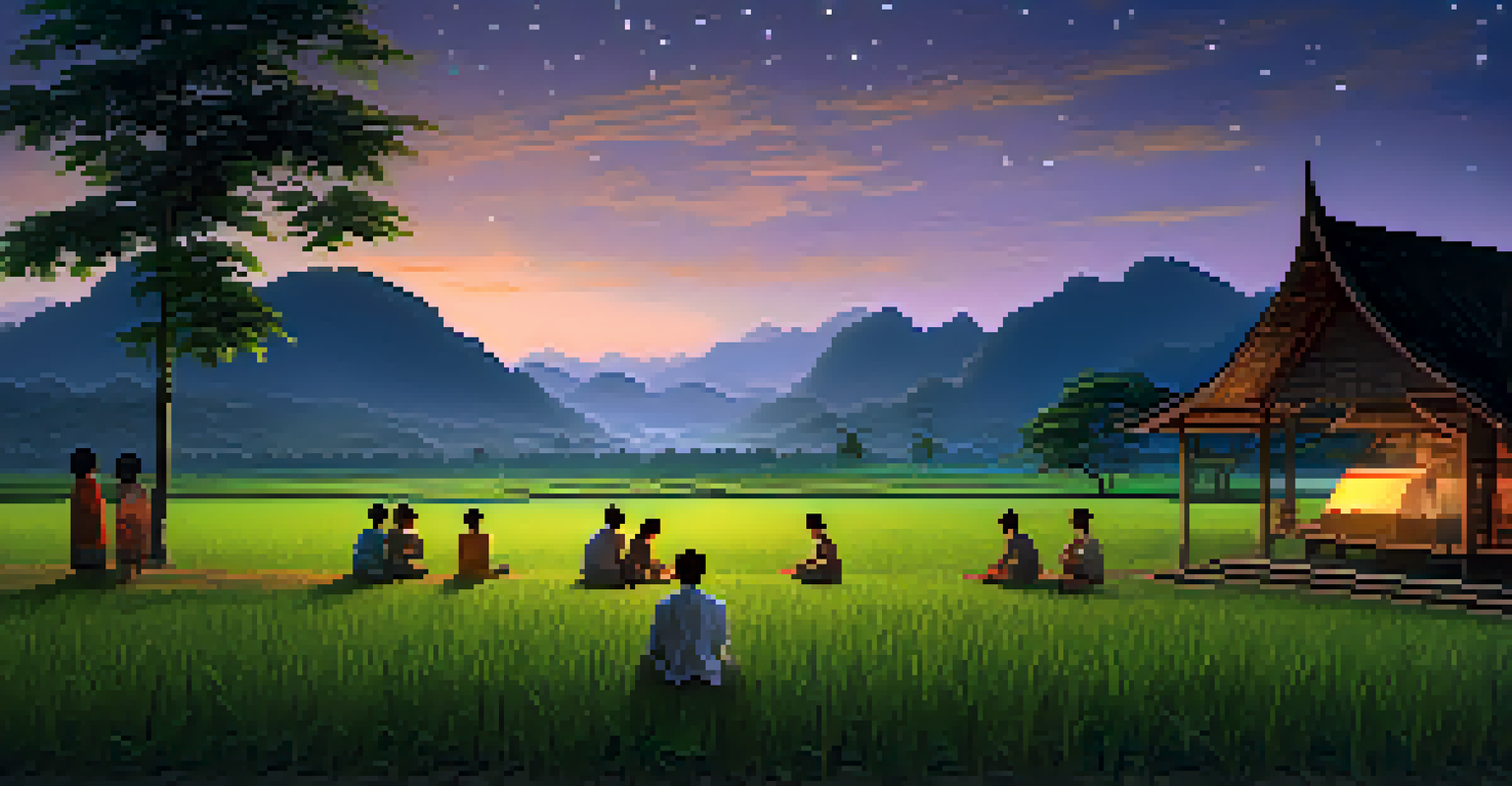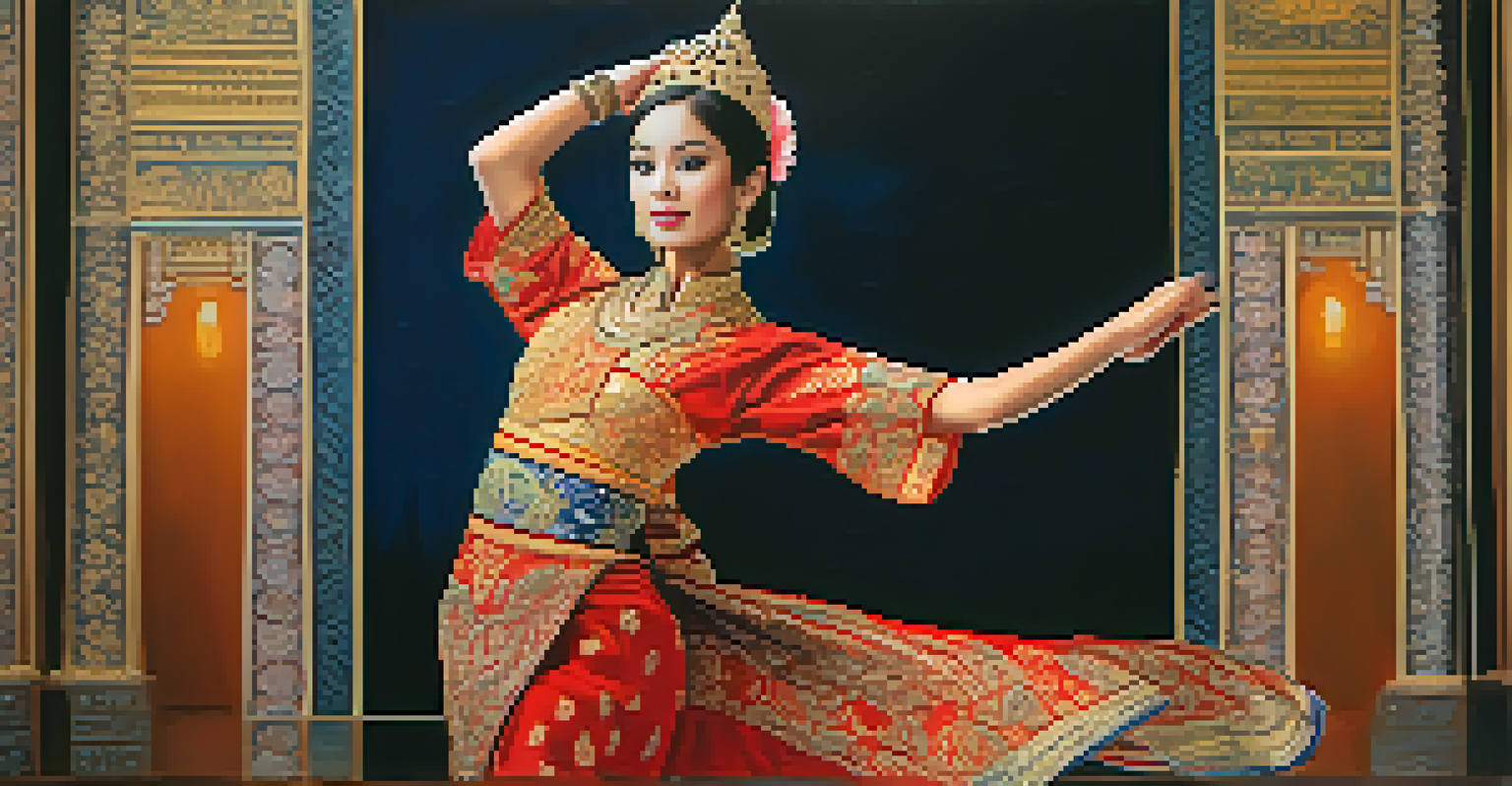The Evolution of Thai Cinema and Its Cultural Significance

The Origins of Thai Cinema: A Historical Overview
Thai cinema traces its roots back to the early 20th century, with the first Thai film, 'Shallow Grave,' hitting the screens in 1927. This period marked the beginning of a new cultural expression, combining elements of traditional Thai art with Western cinematic techniques. Just like the vibrant colors of Thai silk, early films captured the essence of Thai culture, reflecting the society's values and stories.
Cinema is a mirror by which we often see ourselves, our culture, and our society.
The silent film era saw the rise of local talents, who began to tell stories that resonated with the Thai audience. As the film industry grew, so did the exploration of various genres, from dramas that depicted rural life to comedies that offered a humorous take on everyday challenges. These films served as a mirror to society, revealing the hopes and struggles of the people.
By incorporating local folklore and historical events, early Thai cinema not only entertained but also educated audiences about their heritage. This blend of storytelling and cultural reflection laid a solid foundation for the cinematic landscape that would evolve in the years to come.
The Golden Age of Thai Cinema in the 1950s and 60s
The 1950s and 60s are often considered the golden age of Thai cinema, characterized by an explosion of creativity and innovation. Many iconic films were produced during this time, showcasing the talents of actors, directors, and writers who would become legends in the industry. Movies like 'The Legend of the King Naresuan' captivated audiences with their historical significance and stunning visuals.

During this era, film became a crucial platform for expressing national identity and cultural pride. The stories told on screen often blended traditional values with modern themes, creating a unique cinematic language. This fusion allowed filmmakers to engage audiences on both an emotional and intellectual level, making cinema a vital part of Thai culture.
Thai Cinema's Cultural Evolution
Thai cinema has evolved from its early roots in the 20th century, reflecting societal values and cultural heritage through diverse storytelling.
As international interest in Thai films grew, the industry began to gain recognition outside its borders. This era not only solidified the importance of cinema in Thailand but also set the stage for future filmmakers to explore new narratives that continued to shape the country's cultural landscape.
The Impact of Political Changes on Thai Cinema
Political changes in Thailand throughout the decades had a profound impact on the film industry. The rise and fall of different regimes often influenced the types of stories that could be told, with censorship playing a significant role. Filmmakers had to navigate these restrictions while still trying to convey their messages, leading to creative storytelling that subtly critiqued society.
Film is a powerful medium that can bring people together and spark conversations about important issues.
During periods of political unrest, films often served as a form of protest and a means of preserving cultural identity. For instance, films like 'The Moonhunter' tackled social issues head-on, providing a voice for the marginalized. These narratives not only entertained but also educated audiences about their rights and the importance of social justice.
The resilience of Thai filmmakers in the face of adversity underscores the power of cinema as a tool for social change. Despite challenges, they have continued to produce films that resonate with the collective experiences of the Thai people, highlighting their ability to use art as a form of resistance.
Modern Thai Cinema: Trends and Innovations
In recent years, modern Thai cinema has embraced a variety of genres, from horror to romance, reflecting the diverse tastes of contemporary audiences. The advent of technology has also transformed filmmaking, allowing for more sophisticated storytelling techniques and visual effects. Films like 'Shutter' and 'The Love of Siam' have gained international acclaim, showcasing the talent and creativity of Thai filmmakers.
Moreover, modern films often address pressing social issues such as gender equality and environmental concerns, making them relevant to today's audience. This shift in narrative focus demonstrates a growing awareness among filmmakers of their role in society. Just as Thai food balances flavors, modern cinema blends entertainment with meaningful commentary.
Impact of Politics on Filmmaking
Political changes in Thailand have significantly influenced film narratives, with filmmakers using cinema as a medium for social critique and cultural preservation.
The globalization of cinema has opened doors for collaborations with international filmmakers, further enriching the Thai film landscape. By sharing unique stories and cultural experiences, Thai cinema continues to evolve while maintaining its distinct identity, contributing to the global narrative of storytelling.
The Role of Film Festivals in Promoting Thai Cinema
Film festivals play a crucial role in the promotion and appreciation of Thai cinema, providing a platform for filmmakers to showcase their work. Events like the Bangkok International Film Festival attract global audiences and industry professionals, fostering connections that can lead to new opportunities. These festivals celebrate the rich tapestry of Thai stories, helping to elevate the country's cinematic profile on the world stage.
Additionally, film festivals often highlight emerging filmmakers, giving them the chance to present their unique perspectives. By featuring a diverse range of films, these events encourage dialogue about cultural issues and allow audiences to engage with different viewpoints. They serve as a melting pot of ideas, much like a Thai curry that combines various ingredients to create a flavorful dish.
Through workshops, panel discussions, and networking events, film festivals also contribute to the development of skills within the local industry. This focus on education and collaboration helps to ensure the continued growth of Thai cinema, fostering a new generation of storytellers who will carry the torch forward.
Cultural Representation and Identity in Thai Films
Cultural representation is a significant theme in Thai cinema, as filmmakers often explore what it means to be Thai in a rapidly changing world. Films address the complexities of identity, showcasing the struggles and triumphs of various communities within Thailand. This exploration not only resonates with local audiences but also provides insight to international viewers about the richness of Thai culture.
By depicting traditional customs, family dynamics, and societal challenges, Thai films serve as a bridge between the past and present. They highlight the importance of cultural heritage while acknowledging the influence of globalization. Just as a traditional Thai dance tells a story through movement, cinema conveys narratives that reflect the evolving identity of the nation.
Modern Trends in Thai Film
Contemporary Thai cinema embraces various genres and social issues, utilizing advanced technology and global collaborations to reach wider audiences.
The growing focus on diverse narratives within Thai cinema allows for a more inclusive representation of society. Filmmakers are increasingly telling stories from underrepresented perspectives, enriching the cinematic landscape and fostering a sense of belonging for all viewers. This commitment to authenticity not only strengthens cultural ties but also promotes unity within the community.
The Future of Thai Cinema: Challenges and Opportunities
As Thai cinema continues to evolve, it faces both challenges and opportunities in a rapidly changing industry. The rise of streaming platforms has transformed how films are distributed and consumed, prompting filmmakers to adapt to new trends. While this shift presents challenges, it also opens up opportunities for wider audience reach and innovative storytelling formats.
Moreover, the increasing globalization of cinema means that Thai filmmakers must navigate a competitive landscape. However, this also encourages creativity and collaboration, as local filmmakers can draw inspiration from international influences while remaining grounded in their cultural roots. This balance is crucial for crafting stories that resonate with both local and global audiences.

Looking ahead, the future of Thai cinema is bright, with a vibrant pool of talent ready to explore new narratives and push creative boundaries. As the industry embraces change and innovation, it will continue to hold a mirror to society, reflecting the hopes, dreams, and realities of the Thai people in an ever-evolving cultural landscape.